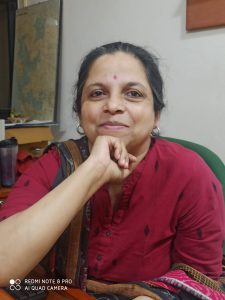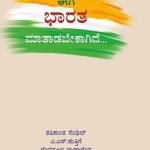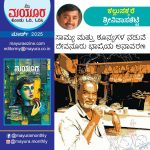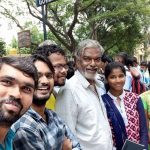Being Dalit after Gandhi and Ambedkar-Insights from Devanoora Mahadeva
[This article is Selections from the works of Devanoora Mahadeva-Compiled, edited and translated by – journalist Bageshree Subbanna. Published in the Book- REASONING INDIAN POLITICS, Edited by Narendra Pani and Anshuman Behera. ಪತ್ರಕರ್ತೆ ಬಾಗೇಶ್ರೀ ಸುಬ್ಬಣ್ಣ ಅವರು ಆಯ್ದು, ಸಂಪಾದಿಸಿ, ಸಂಕಲಿಸಿರುವ ಈ ಲೇಖನವು ದೇವನೂರ ಮಹಾದೇವ ಅವರ ಬರಹಗಳ ಒಳನೋಟಗಳಿಂದ ರೂಪುಗೊಂಡಿದೆ. ಈ ಲೇಖನವು, ನರೇಂದ್ರ ಪಾಣಿ ಹಾಗೂ ಅಂಶುಮಾನ್ ಬೆಹ್ರಾ ಅವರು ಸಂಪಾದಿಸಿರುವ “ರೀಸನಿಂಗ್ ಇಂಡಿಯನ್ ಪಾಲಿಟಿಕ್ಸ್” ಪುಸ್ತಕದಲ್ಲಿ ದಾಖಲಾಗಿದೆ. ]
The words of African writer Chinua Achebe after visiting a village near Mysuru left me shaken. “I saw untouchability in your villages,” he told me, “and it has made me a sadder man forever. In Africa we have people who are called ‘God Children’. It is regarded a sin if their blood is shed on earth. But here shedding the blood of Harijans is seen as a good deed!”
I had never seen any writer, including myself, as disturbed as Achebe was by the practice of untouchability. Our minds and blood seem to be frozen. Caste has nipped our sensibility and tactility in the bud. Untouchability is horrific, but it has become part of our everyday existence.
In Africa, thousands of Blacks were massacred for protesting against discriminatory apartheid laws. Tens of thousands had to rot in prisons. When the protests intensified even a congregation of Blacks became a punishable crime. The worst that can happen when the law itself turns criminal happened there. Every time I think of this horror, I feel that the repression, cruelty, violence and the killings which may have taken place in ancient India, to throw out an entire community of people from the varna and caste system and make them accept untouchability, were repeated in more recent times in South Africa in the form of Apartheid.
How do we understand the relationship between untouchability and apartheid? Was the first phase of apartheid untouchability? Or was untouchability the great-grandfather of apartheid? Perhaps, when a mode of segregation and restriction survives for thousands of years misusing religion, religious strictures and gods, it becomes untouchability.
In Khedda operations used for capturing elephants, they dig a deep pit in the forest and make it invisible by covering it with sticks, leaves and tree branches. Then they beat drums to create a din, forcing the elephant to run towards the pit. Unable to see the covered pit, the elephant falls into it. The trapped elephant is then chained. It is later lifted from the pit and beaten and tortured till it is tamed. The tamed elephant slowly forgets its natural character and becomes the humble servant of its tamer. Servitude becomes its nature. The elephant called the Black in South Africa was pushed into the pit and chained. Attempts were made to tame it through violence and torture. But this elephant, the African Black, could not be tamed.
But the elephant called the Indian untouchable has been tamed. Since he was tamed in the ancient times, we do not see the cruelty of it all. The one who tamed it has no memory of what was done; the one who is tamed doesn’t know that he has been tamed. Discrimination has spread through society and become naturalized. Cruelty is hidden here, like an invisible ghost, and manifests itself at will.
The wound of untouchability
My elderly friend Prof. Mariswamy once narrated to me an incident that happened when he was a higher primary school teacher back in his village. One day he was spotted by an elderly man while he was waiting for a bus in a locality dominated by Lingayats. The old man called his son and asked who the new man sitting on the stone bench in front of their house was. The son described him as “the school teacher and the son of toddy seller Madayya.” The old man showered the choicest abuses on Prof. Mariswamy and asked him to get up and leave instantly.
Yet another incident, narrated by Daya Pawar in his autobiography, testifies that India cares more for caste and Varna than even gods. The incident took place when Pawar was still a boy and had gone to his grandmother’s place. One day there was some trouble in the village temple. He went to see what it was out of curiosity and found a lunatic from an upper caste beating the god’s idol with footwear. The crowd gathered there was watching the spectacle, stupefied. Suddenly, one man in the crowd noticed that a Mahar boy had entered the temple. The crowd, till then busy watching the god being beaten up, suddenly turned their attention on the untouchable boy. They beat him up and pushed him out of the temple, cursing him for making their temple impure. Who is the real lunatic here?
In India even the poor god has been made subservient to the caste and the four-tier Varna hierarchy! Buddhism that did not accept it got thrown out of the country. Jainism and Lingayatism survived, turning themselves into castes. The great intolerance towards Christianity and Islam may also be stemming from the fact that they have refused to transform themselves into castes. Part of the intolerance towards Dalits could also be out of the fear that they might embrace Buddhism, get elevated from caste into a religion, and Buddhism might return to this land.
India is wounded, but fails to feel its own wound. The wounds of untouchability, caste and communalism have spread toxicity in the entire body and it has spread to the brain, driving the nation insane. But this insanity passes for culture and tradition. Half the energy of every individual born here is spent in fighting this madness. If there was a realization of this wound and the madness caused by it, society would perhaps have seen reason: that the untouchable community has not killed, trampled upon or looked down upon anybody; that it deserves respect rather than derision. The dignity of the community – thrown out of villages at one point of time for refusing to be “servants” and now shattered by poverty and humiliation – would also be visible.
Narrating the Lingayat locality incident, Prof. Mariswamy had observed: “We simply thought that what we went through was how life was meant to be until we read Ambedkar. His writings helped us recognize the gaping wound as a wound.” Those who cannot bear the humiliation of being an “untouchable” often hide their identity. But those who can place it on the broader ideological premise, given to us by Ambedkar, long for liberation. This liberation is not of one individual or one community, but of society as a whole.
The big losses
We need to think about what we have really lost on account of the caste system. Forget property, status, position and comforts. An individual, born in a caste, loses his sense of justice and truth. Caste-based customs blind his conscience and injustice does not even appear to him like injustice. He is untouched by the joys and sorrows of people who are not of his caste. Sometimes even the happiness of a man of another caste makes him unhappy and the other man’s troubles bring him joy! In a word, it leaves his sensibility leprosy-ridden. It is horrifying the way caste has left us dwarfed and diseased. This seems to me a greater loss than anything else. We need to liberate ourselves from caste to guard the sense of justice and truth within us, to preserve our sensibility, to respond as human beings. We have to transgress caste for our own liberation. We have to inculcate this attitude at least in our children for the sake of their future.
The writer Avalahalli Krishna and I once went to a village where Dalits were not allowed to enter a hotel. The state of the thatched structure that passed off for a “hotel”, its unhygienic interiors and the foul-smelling gutter nearby made Krishna ask me, “Aren’t Dalits better off not eating here?” The place was so bad people would have to pinch their noses while eating. Yet Dalits of the village were keen to enter the place. I said in response, “What we are demanding is entry into their minds and hearts.”
Interestingly, in an article written back in 1944, before most of us were born, our great writer Kuvempu talked about how we should confront the issue of temple entry. He cited an episode where a temple was cleansed after two men, who were well educated and cultured, entered it, because they belonged to an untouchable caste. “The ‘touchable’ youth should take this insult meted out to their ‘untouchable’ brothers as an insult to them as well and shun going into such temples. They should seek god outside temples, in the beauty of nature, in the rising sun, in literature and culture and in the service of the Narayana-incarnate poor. They should thus break the pettiness of religion… Let us remember that those who are arguing for temple entry of Dalits are doing so for the redemption of the upper castes themselves and to help them achieve a larger vision and not for the salvation of untouchables.”
It has been 72 years since this was said. We, who call ourselves progressive, have not been able to achieve this vision. Our life today would have been bearable if we had managed to put into practice at least a part of this vision. Townships being built exclusively for some castes would have appeared ugly to us. Perhaps there would have been fewer murders and riots in the name of caste and religion. Business would have been less brisk in the shops of hate-mongers.
Invoking caste against caste
We find ourselves in a situation today where we need to invoke caste itself to arouse Dalits wounded by the caste system into action. The lowest of the low standing upright to protest stridently against injustice can shake the inflexible caste system.
One Jayadeva Poojar once wrote that I have built an “edifice out of untouchability and am constantly hoping that the edifice does not collapse.” What could I say, except pray that the edifice does collapse! I hope he prays for my prayers to be answered!
He went on to say that one of the reasons for the backwardness of Dalits is “their insistence on keeping on chanting the mantra of past exploitations.” Just the example of what happened in Khairlanji in Maharashtra – where a family of Dalits was massacred for daring to hold their heads high; the mother and daughter brutalized and raped and the genitals of the sons severed – would make one wonder what exactly is Mr.Poojar’s notion of ‘the past’? If that is past, then are we living with the dead?
He has argued that my mind is “filled with untouchability.” Indeed, my mind is filled with the wounds of untouchability. For, does a day pass in India without Dalits being attacked, killed, insulted or raped? Indian untouchables suffer not only poverty, but also social exclusion, insult and stigma. The poverty of those with social and cultural mobility is the poverty that still has its wings intact. But the poverty of untouchables and backward castes is poverty which is forced to crawl because its wings have been clipped.
The enemy within and the enemy without
But we also need caution and clarity on how much of caste identity we need and for what purpose. We need awareness and wisdom on how to preserve secularism even while organizing ourselves along caste lines in our struggle. This is a tight-rope walk. It is not complimentary to the spirit of our Constitution if the consolidation of a caste hardens its own caste-related customs and discrimination. The Constitution will acquire a moral legitimacy only if it can loosen caste-based customs and discrimination and take the community forward.
In this scenario, organizations and communities that ought to be fighting for the common cause of equality seem to be crippled, crawling and blinded by cataract. Organizations and political parties which should collectively strive to realize the dream of equality and equity are not together. They are busy identifying separate enemies and celebrating the differences defined by their choice of enemies. It is akin to the Brahminical notion of purity and pollution. Over time, as inertia sets in, they may even forget these enemies and start seeing enemies in those around them. The organizations of Dalits, women, environmentalists and farmers seem to be forgetting the larger ideals and have allowed their identity politics to bloat like elephantiasis and render them immobile.
There was a time when the Dalit Sangharsha Samiti was one organization with thousands of activists. They were a strong, palpable presence. Now we have several splinter groups of Dalit Sangharsha Samitis and lakhs of activists. But then, we don’t know where they are. We need to ask ourselves why this is so.
Dalit organizations stand divided today and so do Dalit communities. Worse, there is much animosity between them. What will happen if the present situation continues? The Dalits staying in hamlets away from their villages will remain there. The poor and subaltern classes inside villages will also be pushed outside or into slums. In the situation unravelling before us, the day may not be far when they are pushed out and made untouchable to the entire political scenario.
What is the way out of this situation and who is to show us the way?
The deity in the stepping stone
Let me digress here a bit and tell you a story.
There was a small stream running across a village and in the middle was a stone. People stepped on it to cross over. One day a man turned back after he crossed the stream and found to his shock that the stone was in fact the idol of a deity. He was terrified and profusely apologized to the deity for stepping on her. As he started walking away, someone grabbed his feet. It was the very same deity. “What makes you think you can get away without building a temple for me?” she demanded.
This sums up our own situation today. We are fine so long as an icon or an ideology helps us, in practical terms, cross hurdles in our path. But the minute we stop to fold our hands, we are compelled to build temples for them. The deity might even ask for blood sacrifice. Human beings end up doing their bidding when gods or demons possess them. But it’s a different story when people can turn around and possess them instead.
Today there are hundreds of organisations, factions and ideological streams in the name of Mahatma Gandhi, B.R. Ambedkar, Karl Marx, Ram Manohar Lohia and others. We often find them fighting with each other. But do we really possess these icons? Have we managed to catch their pulse? If we fail to do so, these icons might end up quite like the river deity.
Icons under a pipal tree
Before Independence, inequalities and oppressive practices seemed more straightforward and more easily comprehensible. Perhaps our heroes back then could fight lone battles. The colours of oppression, discrimination and inequalities are now all mixed up. To complicate matters, the aspirations of society too are very different. We are now like silkworms that weave narcissistic cocoons around themselves and eventually kill themselves. We need to borrow straws of love, tolerance and equality from each of our icons to build our own open nests. This has to be done in small ways every day, without waiting for that one grand day when we come to power and take control. Big things tend to get caught in dragnets, while small things escape, survive and live on.
How do we do it? The only path I see is to sit all our icons down together under our own village pipal tree and have conversations with them on our contemporary issues, on what we can do to preserve love, tolerance, self-respect and self-reliance in our midst today. Why does our prime minister bring down the import tax on Chinese silk just before his trip to China, resulting in the price of our silk plummeting; farmers, unable to get remunerative prices, destroying their own crops; and many committing suicide? Emperors of yore took gifts of fine silk cloth, but our prime minister appears to be taking the head of our silk farmers as gift! What would they have to say about separate townships being built for different castes in India? We need to ask them all of them these questions and listen to what they have to say about the tragedy of the politics of our time.
Quarrels bring them alive
Much has been said again and again about the differences between these icons. The quarrels between Gandhi and Ambedkar, in particular, have been widely debated. In fact, the clash between the two is still on and very intensely so. This only proves they are not dead. If anything, it means they are more alive today than ever before.
I see it as a positive sign. Finding them alive today is like a drowning man finding a straw to hang on to in a cheerless situation where everyone has begun to believe that all principled positions and struggles are disappearing, overshadowed by the triumphant dance of global capital.
Before I get to their quarrels, I want to cite a few flashes of mutual respect, trust and admiration they had for each other. Let us certainly get to the quarrels after that.
In the statement made after the Poona Pact, Ambedkar is quoted as saying: “I admit that I am surprised, in fact greatly surprised, when I realised after meeting him [Gandhi] that there is so much similarity between us.”[1] How do we understand this? Gandhi told Gora’s son-in-law in 1946 that he should become like Ambedkar and work for the eradication of untouchability and caste. Untouchability should disappear at any cost, he said. How do we understand that? As D.R. Nagaraj records in his book ‘Samskruthi Kathana’ (The Story of our Culture),[2] when everyone else called Gandhi ‘Mahatma’, the Mahatma himself described Ambedkar as ‘Mahatma’. What does that suggest? Was everything between them – quarrels and all – a mutual give-and-take between two Mahatmas?
What was the source of their quarrels? Gandhi was, to begin with, a conservative, hide-bound traditionalist. As he walked and stumbled he grew into being progressive. He took every step keeping an eye on the conservatives and traditionalists who had the community in their firm grip, watching if they were also keeping pace. He was trying to drag them along with him as he walked ahead. Historian S Chandrashekar observes that while Gandhi descended from political activism to social work, Ambedkar ascended from social activism to the political arena. Did their quarrels intensify because of these differing trajectories?
Being contemporaries, they had to react to the events around them on a day-on-day basis. To make matters worse, Gandhi hurt Ambedkar deeply by being petty at the Round Table Conference. Ambedkar’s reactions have to be understood in the context of all these events. That is to say, we should place Ambedkar’s specific reactions in specific contexts and understand him as a whole rather than suffocate him by trapping him in tight glass enclosures of context-bound reactions. The same goes for Gandhi.
Village as heaven or hell
One of the central themes of the quarrels and repartees between Gandhi and Ambedkar is their perceptions of the Indian village. Gandhi was a man who dreamt of turning each village into a self-sufficient paradise. But Ambedkar saw the Indian village as a dark hell. If Gandhi believed that India’s liberation was in its villages, Ambedkar wanted to liberate India from its villages. For one the village was an idyllic dream; for the other a cruel reality. Indeed, the village was a nightmare. Those were days when the lowest communities in the villages could not even breathe. Is it any surprise that Ambedkar viewed the Indian village as veritable hell? But how about now? With the implementation of the gram panchayat system, there are several groups in each caste aligning with different political parties. It may be a temporary phenomenon fuelled by the competition and compulsion of party politics, but we should also acknowledge that there is a certain dynamism pointing to the possible breaking of caste confines. Thanks to reservations for positions of power in Panchayats, a Dalit woman became the president in my own village. I – who could not even have imagined an untouchable entering the gram panchayat office during my childhood – am witness to this today. Can we afford to be blind to this dynamism?
Let us consider some of the views that Gandhi held in the 1920s as any contemporary would: Hindu religion is founded on the caste system; the seeds of Swaraj are in the caste system; caste is just a form of social control; inter-dining or inter-caste marriages are not prerequisites for national unity; the caste system is a natural stratification of society; any effort by anyone to annihilate caste must be opposed; and so on. Surely, we too would oppose and protest against these views. Indeed, as strongly as Ambedkar did.
But that rigid, conservative Gandhi does not remain the same. Gandhi dies every day and is re-born every day. Gandhi, who by 1928 encouraged marriage between sub-sects of the same Varna, takes one step at a time and by 1946 makes it his principle to attend only inter-caste marriages between Savarna Hindus and Harijans. Later he denies permission for any marriage in Seva Gram unless the bride or the groom is a Harijan. He reaches a position that caste has to disappear if we have to eradicate untouchability. What would have happened if Gandhi back in 1920 had the same ideas he came to acquire in 1946? The castes and religions of India would have swallowed him whole and digested him, leaving no trace of Gandhi at all. Also, the castes and varnas of India would have remained unshaken and deemed it their religious duty to make sacrificial goats of the untouchables who were daring to raise their heads just a little. We need to understand this as well.
But then, I fail to understand how Gandhi, who evolved a great deal in one lifetime, could till the very end hold on to his belief in hereditary professions. It is hard to fathom these views even though he did believe that any profession was only meant for minimalist subsistence. Even great skills end up becoming mechanical in a hereditary profession. In contrast, more possibilities open up and greater creativity emerges when there is a change in the hereditary profession. We need to pick a small quarrel with the forever-evolving Gandhi to convince him of this. Gandhi declared in 1946 that violence is born of inequality and non-violence of equality, viewing non-violence and equality as two faces of the same coin. He made this statement while talking of his dream of a class-less and caste-less Indian society in which Brahmins would marry Harijans naturally and only one caste would remain. This statement of Gandhi is on a par with Marx’s epic vision that the state withers away.
Considering the positions they reached towards the end of their lives, where and how would Gandhi and Ambedkar be if they were alive now? Would they find themselves thrown into the same old age home, listening only to each other’s complaints, helplessly watching all that was happening before them and gazing at the sky with hands on their heads? Or would they listen to D.R. Nagaraj, who would visit just to tease them saying, ‘Be an Ambedkarite within the village and a Gandhian outside it’? Would they discover a hidden magical treasure in this statement, plead with people to listen to the ankle bells of this wisdom, on seeing that none listen to them conclude that they were living among the dead, and finally pray for their own deaths?
That is a disheartening scene we can do without visualizing. Instead, we should crack Nagaraj’s pithy riddle and find a way of curing our society of the age old hallucination of ‘higher’ and ‘lower’ castes. This is hard to cure because we don’t in the first place see it as a disease. If we visualize being Ambedkarite within a village like Nagaraj said, we visualize the homes of the so-called upper caste people with photos of Ambedkar hanging on their walls. This small act could cleanse them from within, make them more human. The principles of equality that Ambekar professed will cure them of their delusions of grandeur. This requires a radical atmosphere in the village, the kind that was possible during the Vachana movement in 12th century Karnataka. In the larger context beyond the village, we need an economy based on the humane values that Gandhi believed in and a vision of the world as a family that he had.
Quarrels are inevitable if we place ourselves as contemporaries of Gandhi and Ambedkar. But if you view both in the wider context, the quarrels may even appear like a game of love. I leave it to each one’s imagination to decide who is the man and who is the woman in this game! When I once said that Ambedkar is the prodigal son who left home because he was discriminated against, some missed the point and interpreted it literally as the story of the rightful heir being rendered outcast and homeless. But we should give up the exercise of digging up graves, counting and worshipping bones, indulging in hair-splitting arguments, seeking out only differences, following exclusionist customs and killing both Ambedkar and Gandhi in the process.
Generational icons
The works and lives of Gandhi and Ambedkar influence us in very different and complex ways.
It brings to my mind an anecdote my friend and poet Siddalingiah narrated to me. An old man in a village once told his grandson: “There was a great man in our time called Mahatma Gandhi. He chased the British out of the country and brought us freedom. We are what we are today because of Gandhi.” The grandson said in reply: “Ajja, when you were small, there was also our own man called Ambedkar. He fought for the welfare of our community. We are what we are today because of him.” A ripe fruit talks to a bud about Gandhi and the bud talks right back to the ripe fruit about Ambedkar. There is gradualness in the first response and great speed in the second. The two might seem contradictory for this reason. I think the first generation of literate Dalits had escaped being trapped in this apparent contradiction by understanding the essence of both these men. While the young generation of Dalits hangs the picture of only Ambedkar in their homes, the previous generation hung pictures of Gandhi and Ambedkar side by side.
How then did the previous generation view the Ambedkar-versus-Gandhi debate? Did they see them as parents fighting over what is good for their children? A mother might want her child to go to an English medium school. The father might insist Kannada medium is better. They might end up fighting. But what is at the core of the fight but their concern for welfare of the child? How do we understand the Poona Pact? Was it not akin to saying: “I have made mistakes, but please do not divorce me?”
The views of Gandhi and Ambedkar on Hinduism are often seen as being contradictory. While Ambedkar’s arguments were grounded in logic, those of Gandhi went beyond logic. There are always differences of opinion and arguments between contemporaries. We should judge them by their end result. Why did a Hindu extremist like Godse kill Gandhi? Why did Brahmin ghettos celebrate it as the end of the Kalki avatar that brought about inter-mingling and pollution of castes? What then was Gandhi doing within Hinduism? He was trying to distil the stagnant sewage of the Hindu faith to get pure water. This had resulted in the larvae living in this stagnation – which were incapable of becoming butterflies – feeling suffocated. How else can one understand his position? How else can we understand Gandhi who had, towards the end of his life, taken the position that he would only attend inter-caste marriages?
Gandhi appears to me like a man living within the House of Hinduism, sawing away at pillars that stand for caste discrimination. Ambedkar appears like a man standing outside and throwing stones at the house of inequalities. A few of those stones may have hit Gandhi and he may have bled. This bloodshed would have given the whole episode the appearance of a pitched battle between Gandhi and Ambedkar. But were they not, in reality, on the same side of the battle?
Why then is Gandhi misunderstood? I can only make a surmise. Gandhi treated untouchables like children. He could have perhaps escaped this misunderstanding if his perception was inverted and if he had treated untouchables like his elders rather than his children. Though one could argue that it is all the same, it makes a distinct difference to the patterns of our behaviour. When there is competition or confrontation between untouchables and upper castes, the attitude would be one of impatience and anger when they are viewed as children. The response is: ‘Look at the audacity of this person whom I nourished and raised!’ But the attitude towards one’s own parents would be quite contrary. It would be on the lines of: ‘They are after all people who looked after me. So what if I even lose to them?’ Looking upon them as elders rather than children would be even historically more accurate, considering that Dalits are the first inhabitants of this land.
How should Dalits receive such a Gandhi? Gandhi, it is said, wished to be born as a ‘Harijan’ in his next birth. Good if that indeed happens. But we don’t know about that. For now, Gandhi can be reborn in our midst if we take Gandhian literature into the Dalit fold, edit it. The good of the whole community might lie in such an exercise.
We should be cautious about one thing as we say this. Yesterday’s Gandhi will be a changed man today. Today’s Gandhi will be a changed man tomorrow. This is the Gandhian way ahead for Gandhian thoughts and aspirations. The task of carrying a whole community forward with you is a difficult one. People have picked out parts of Gandhi and claimed them as ‘the’ Gandhi at different points. We need to re-read and re-fashion Gandhi for ourselves keeping in mind his goals and the footsteps he has left behind in the last phase of his life. The wisdom and thinking of Lohia might help us in this exercise. We also need to combine Ambedkarite thought with Lohiate thought and achieve cohesion.
I see Gandhi as a stern father, JP as a helpless mother, Vinobha as an unmarried, ritual-bound sister, Lohia as a nomadic son who does not want to remain home-bound and Ambedkar as the other son who is fed up with the discrimination at home and has decided to stay out. This is our family. We are inheritors of this legacy. How else can I view this? Where do we go from here?
‘Para’ under the pipal tree
What is your vision of life and the world? Grand questions like these are often thrown at me. My tongue falters if I try to use big words and jargon. But what flashes before my eyes is the practice of ‘Para’ among the Dombaru community, a traditional community of acrobats.
This nomadic community of entertainers often hold a feast called ‘Para.’ They gather together in an open field under a big tree, cook whatever grains they have gathered and eat together. Before they start eating, they count people who were unable to make it to the feast for various reasons. They may be people old and infirm, ailing or pregnant. They keep aside the share of those absent before they begin to eat. A pregnant woman gets two shares, counting in the child inside the womb. This, I could say, is my “world vision.”
The pipal tree over the heads of Dombaru – of brotherhood, equality and egalitarianism – was the same tree under which Buddha attained enlightenment. It is the same tree under which Gandhi, Ambedkar, Lohia and our Vachanakaras sat. Let us bring Marx too under the same tree. In fact, we might do well to give all the others a bottle each of the blood of Marx who had a vision of the world where wealth is equally distributed.
Yes, this grand tree has been felled by the winds of changing times. Indeed it has been felled by the ever-hungry Bakasura of capitalism that has robbed people of all their human values. Globalisation has successfully propagated the grand myth that the pipal tree died a natural death.
But let us remember that this tree we have declared dead can come alive from anywhere, even from the crevices in a concrete jungle. A sapling can be born in another place, getting acclimatized to the quality of the new soil. It can sprout, breaking through the walls.
From Icons to Practice
This faith can give a new sight to our movements like Dalit Sangharsha Samiti and Karnataka Rajya Raita Sangha. These organizations, which once spurred society into thought and action, but now appear tired and directionless. They need to shed their slough. We often speak of Buddha, Basava, Allama and Gandhi. But we should remember one important thing as we chant their names: They all believed that the enemy is also within ourselves and constantly strived to fight that enemy. They believed that jealousy, selfishness, greed and ego are enemies within which also need to be fought. But organizations that fight for an equal and egalitarian society often only fight the enemy without. Where will that finally leave us? We might reach a point where we believe that the man who fights corruption today is invariably the man who will be corrupted tomorrow. What do we achieve by becoming in future what we fight today?
We need to find a golden mean in our fight. Our enemy is half within and half without. Would this knowledge give a new direction and new idiom to Dalit Sangharsha Samiti and Karnataka Rajya Raita Sangha? We would have to dedicate as much time to recognize and root out the enemy within as we have done to fight the enemy without. We have to walk with the caution that the values and people we are impatient with and protesting against could also be lurking within ourselves. Can we achieve this? Do we indeed have any other way?
We have now come together to form the political party Sarvodaya Karnataka Paksha, instead of losing more time in debating the need to unite, bringing together one faction of Dalit Sangarsha Samiti and one faction of the Karnataka Rajya Raitha Sangha. We hope to include others as we go along. There have been efforts like this in the past in Karnataka. Though they did not result in the farmers groups and Dalit groups entirely shedding their differences, they did bring these organizations closer. They underlined their essential desire to come together. Such efforts made them see that there is no way forward if we do not sink our differences and unite to shape our politics. We need to come together in the full knowledge that even our joint forces are but a morsel in the big belly of politics.
Back in the Seventies, the number of people getting elected to the State Legislature from the Socialist Party was quite small, no more than four or five. But the effect was such that one could feel Socialist thought pulsating through the state and it felt as though the Legislative Assembly was filled with socialists!
That is now a distant dream. Politics has since then become a directionless horse. Those on the mount have no sense of direction. Progressive individuals and organizations, including myself, have ended up like little boys on the periphery of a playground, picking up balls that once in a way come their way. We neither enter the ground to play nor do we turn away. We have failed to see that the first lesson of politics is to stay on the ground, whether we win, lose or forfeit our deposit.
In the present context marked by ideological bankruptcy, only awareness that we can save ourselves by saving like-minded parties can keep us afloat. We should help a weakening Republican Party of India and stagnant communist parties to grow with us. We should try not to create hurdles for Bahujan Samaj Party which has made serious gains in the recent years. These are not favours we will be doing to others but to ourselves too. Organizations born out of activism have a tendency to not see anything beyond their own ideology. We often come across as feuding cousins, though we are brothers in reality. How can we survive if we cannot come together even in this situation of crisis? I would even request Naxalites to shun arms and join hands with us.
Our idea is to take forward the dream of Lohia, who wanted to build the Socialist Party taking Ambedkar into its fold. It could never happen because the latter passed away before it could become a reality. We are planting his dream in Karnataka now. Our model is the ideal of equality that people like Buddha, the Vachanakaras of Karnataka and Gandhi first achieved within them and then tried to achieve in the world outside. Unity should be based on the principle of equality. The same goes for development. All ideas that can make this possible – whether they come from our tribal communities or from distant corners of the world – should be made our own. We should become artistes like the weaver bird that fetches straws from everywhere to build its nest.
Negotiating the Indian mind
When I think about how the representative Indian mind works I always remember an incident involving farmers’ leader Mahendra Singh Tikait. He had once agreed to attend two farmers’ conventions on the same day and at the same time in two distant towns in Karnataka – One in Bengaluru and the other in Hospet in Bellary district at the other end of the state. There was much curiosity, anxiety and confusion on which of the two he would choose to attend and there was speculation on it for days on end. It was a treat for the media!
Finally he arrived at the Bengaluru airport. The media people were on to him the next moment. All of them had one question – “Which way are you headed?” One was organized by former prime minister H.D. Deve Gowda in Bengaluru. Former minister and the then state Janata Dal (Secular) party president Vaijanath Patil stood smiling next to a posh car to take Tikait to the programme organised by Gowda. On the other side beside an ordinary car stood an ordinary activist sent by farmers’ leader and founder of KRRS M.D. Nanjundaswamy. Journalists kept repeating the same question – “Which way are you headed?”
Tikaitadjusted the loose cloth he had slung across his shoulder with a flourish and said: “I will head to where the real farmers are.” He took long strides to the car sent by Nanjundaswamy.
This is perhaps the wisdom of a representative Indian mind.
On another occasion, after attending yet another convention organised by Nanjundaswamy, he was taken to a travellers’ bungalow to rest for the day. Looking at the room in shock, he complained that the place was too luxurious, the light too bright and bed too big. “I can’t sleep in such a place,” he categorically said. Though Nanjundaswamy tried to convince him that it was only an ordinary travellers’ bungalow, Tikaitwas adamant like a child. Finally, the organisers gave up and arrangements were made for his stay in the home of a farmer who had a rope-cot to spare. Tikait felt at home in a room where the smell and sound of the cow shed wafted in. He slept soundly.
This is perhaps the simplicity of a representative Indian mind.
But the same man, at a later point in time, violently opposed inter-caste marriages. He went to the extent of saying the hands of those who marry out of caste should be chopped off.
This is perhaps the cruelty of a casteist, feudal, representative Indian mind.
Gandhi saw better the first two – the inherent wisdom and simplicity of the representative Indian mind.
Ambedkar saw better the last — the inherent cruelty of the casteist, feudal, representative Indian mind.
How do we preserve wisdom and simplicity, while rooting out the cruelty, thereby inculcating dignity and humaneness into the representative Indian mind? This is the challenge before us today.
Notes:
[1]“Thus Spoke Ambedkar” Vol I (edited by Bhagwan Das)
[2] “SamskrutiKathana” (2002), collection of essays on cultural criticism, Kannada Book Authority









